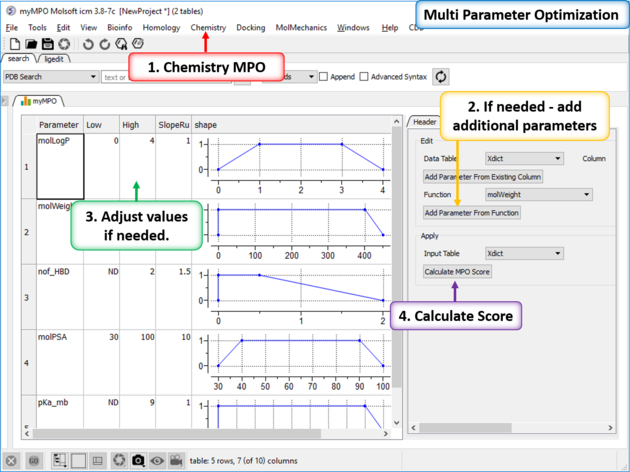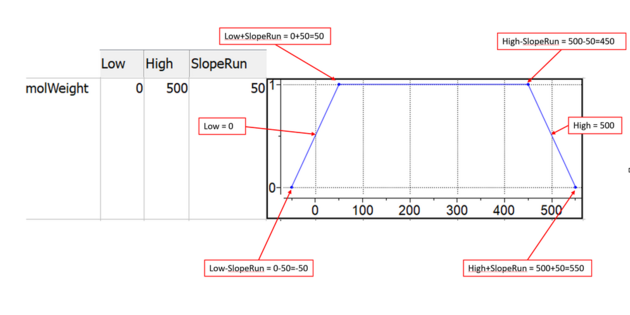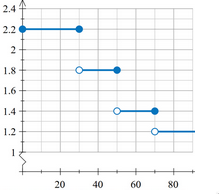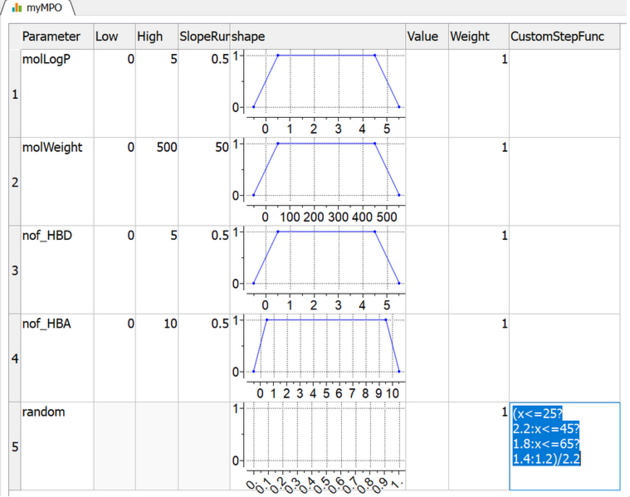| Prev | ICM User's Guide 10.33 Multi Parameter Optimization | Next |
[ Customized Score ]
Multi Parameter Optimzation (MPO) is a method that can be used to derive a score for the relative importance of a number of different chemical properties. You can create your own scores or use the ones built into ICM:
For example:
- Lipinski Rules (LopP, MW, Nof(HBD), Nof(HBA).
- CNS - Blood brain barrier permeation LogP, PSA, MW, pKa of most basic group, Nof(HBD). Model is based on Wager et al ACS Chem. Neurosci. 2016, 7, 6, 767–775.
- QED - Quantitative Estimate of DrugLikeness (see https://www.ncbi.nlm.nih.gov/pubmed/22270643)
About the MPO Method
- Multi Parameter Optimization (MPO) = set of properties + set of desirability functions
- The desirability function is an approach for combining multiple responses in a single optimization equation.
- A desirability function maps the value of a property onto a score in the range [0-1] that represents how desirable a compound with this property value would be.
- Total desirability (MPO score) index can be then calculated as an average.
About the MPO desirability functions in the MPO table The MPO is grouped into a table where each row represents a single property:
- Low, High and SlopeRun: define shape of the desirability function
- Weight : importance
- Formula : expression for automatic calculation
- Value : for discrete columns (e.g. string arrays)
- Name, Color
To run MPO:
- Read in a Chemical table. MPO can work with the 2D sketch in the 'mol' column or using a column containing SMILES.
- Chemistry/MPO/Create New MPO Score
- Select the built-in Lipinski, CNS, QED, parameters or make your own by choosing Empty.
- Choose whether you want to assign property colors and click OK.
- You will then see a panel on the right hand side of the spreadsheet under the table Tools tab.
- If you chose "Empty" you will need to add parameters either from MolSoft's inbuilt functions or from an existing column.
- If needed adjust the High, Low, SlopeRun, Value and Weight columns for each property parameter by clicking in the cell and editing. You will see the plot in the shape column adjust according to your input.

- Click on Calculate MPO Score and a results table will be displayed containing a Score and the parameter bars.
- Sort the Score column (myMPO).

10.33.1 Customized MPO Score |
MPO step function shape is define by 3 parameters: Low, High, SlopeRun (resize column to see the full name)
Below picture illustrates meaning of these parameters.

"Special" cases:
- SlopeRun = 0 defines vertical step

- Low = ND or High = ND defines "open interval" in one direction

Custom step function can be defined using logical expression in the 'CustomStepFunc' column:
-
*In the tools panel select column you want to apply step function to (note you may need to click on table list to refresh column list)

- Click 'Add Parameter From Existing Column'
- Double click on 'CustomStepFunc' for that row and enter expression (formula) which defines step function
- Formula have 'x' as an input variable (values of column from 'Parameter' will be applied)
- Conditional expression can be define in form
? : - Conditional expression can be arbitrary nested,
- For example function below can be defined as: x<=25?2.2:x<=45?1.8:x<=65?1.4:1.2

Note that MPO expects each result from step function to be in range [0-1], so the expression should be normalized (e.g: like below)
(x<=25?2.2:x<=45?1.8:x<=65?1.4:1.2)/2.2

| Prev Select Duplicates | Home Up | Next Combinatorial Chemistry |